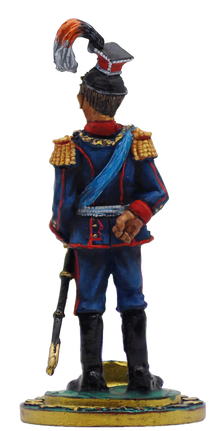
Prince Louis Bonaparte
Napoleon Louis Josef Jérôme Bonaparte (16 July 1864 – 14 October 1932) was the disputed head of the House of Bonaparte from 1891 to his death in 1932, as well as a lieutenant-general in the Imperial Russian Army and governor of the province of Yerevan in 1905. Louis Bonaparte, as he was known, was born in Meudon, France. He was the second son of Prince Napoléon-Jérôme Bonaparte, who was the son of Napoleon's brother Jérôme Bonaparte and of Princess Maria Clotilde of Savoy, daughter of Victor Emmanuel II of Italy. He was educated with his older brother Victor, Prince Napoléon, then lived a quiet life in Paris at the home of his aunt Mathilde Bonaparte. His father directed him to a military career. As a relative of Napoleon Bonaparte, he was not allowed to join the French Army, so he became a lieutenant in the Royal Italian Army in Verona, with the approval of his uncle, King Umberto I of Italy. Because of anti-French sentiment in the Italian Army, he left Italy in 1890 and enlisted in the Imperial Russian Army. In 1895 he was promoted to colonel. In 1902 he was stationed in the Caucasus. When riots broke out in 1905 between Armenians and Azeris in Yerevan, he was named governor of the province of Yerevan and ordered to restore order. In his will, Napoléon-Jérôme designated Louis as the head of the House of Bonaparte, bypassing his first son Victor, who he deemed "a traitor and a rebel". Victor and a majority of Bonapartists disputed this. In 1910, he retired from the

Russian Army as a lieutenant-general and moved to the family estate in Prangins, Switzerland. After Italy entered the First World War, at the request of Tsar Nicholas II of Russia, he became liaison officer for the Russian Army with the Third Italian Army, led by his cousin Prince Emanuele Filiberto, Duke of Aosta. In 1917, he returned to Prangins, though his later travels included trips to Japan and the United States. He died in 1932 from a stroke in Prangins, Switzerland. He never married and had no children.

The Leib-Guards Ulansky Regiment of Her Majesty the Empress Alexandra Feodorovna is a Guards cavalry regiment of the Russian Imperial Army. Since 1857 it was part of the 2nd Guards Cavalry Division. It distinguished itself in battles with Napoleon's army at Austerlitz in 1805 and at Friedland in 1807. The regiment's seniority - 16.05.1651, regimental holiday - on the day of the Ascension of the Lord. Dislocation - Novy Peterhof, St. Petersburg province. Honours - St George's Standard with the inscription ‘For the capture of the enemy banner at Krasnoye and for distinction in the defeat and expulsion of the enemy from Russia in 1812’. Granted on 13 April 1813, new standard - 27 June 1851. On 27 June 1851 the St. Andrew's ribbon was granted in connection with the celebration of the 200th anniversary of the regiment. Since 1884 it has not been in service. 22 Trumpets of St. George with the inscription ‘of the L.-Gv. Ulansky regiment, for excellent feats performed in the memorable campaign safely ended in 1814’. Granted on 30 August 1814. Badges on headdresses with the inscription ‘For Telish on 16 October and the Balkans on 18 December 1877’. Awarded on 17 April 1878.

The House of Bonaparte is a former imperial and royal European dynasty of Italian origin. It was founded in 1804 by Napoleon I, the son of Corsican nobleman Carlo Buonaparte and Letizia Buonaparte (née Ramolino). Napoleon was a French military leader who rose to power during the French Revolution and who, in 1804, transformed the French First Republic into the First French Empire, five years after his coup d'état of November 1799 (18 Brumaire). Napoleon and the Grande Armée had to fight against every major European power (except for the ones he was allied with, including Denmark-Norway) and dominated continental Europe through a series of military victories during the Napoleonic Wars. He installed members of his family on the thrones of client states, expanding the power of the dynasty. The House of Bonaparte formed the Imperial House of France during the French Empire, together with some non-Bonaparte family members. In addition to holding the title of Emperor of the French, the Bonaparte dynasty held various other titles and territories during the Napoleonic Wars, including the Kingdom of Italy, the Kingdom of Spain, the Kingdom of Westphalia, the Kingdom of Holland, and the Kingdom of Naples. The dynasty held power for
around a decade until the Napoleonic Wars began to take their toll. Making very powerful enemies, such as Austria, Britain, Russia, and Prussia, as well as royalist (particularly Bourbon) restorational movements in France, Spain, the Two Sicilies, and Sardinia, the dynasty eventually collapsed due to the final defeat of Napoleon at the Battle of Waterloo and the restoration of former dynasties by the Congress of Vienna. During the reign of Napoleon I, the Imperial Family consisted of the Emperor's immediate relations – his wife, son, siblings, and some other close relatives, namely his brother-in-law Joachim Murat, his uncle Joseph Fesch, and his stepson Eugène de Beauharnais. Between 1852 and 1870, there was a Second French Empire, when a member of the Bonaparte dynasty again ruled France: Napoleon III, the youngest son of Louis Bonaparte. However, during the Franco-Prussian War of 1870–1871, the dynasty was again ousted from the Imperial Throne. Since that time, there has been a series of pretenders. Supporters of the Bonaparte family's claim to the throne of France are known as Bonapartists. Current head Jean-Christophe, Prince Napoléon has a Bourbon mother.
Awards: Sash and star of the Order of St. Andrew the Apostle the First-Called, Collar of the Royal Order of the Legion of Honour (Ordre royal de la Légion d'honneur).






